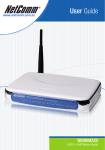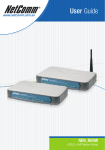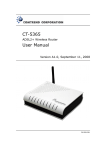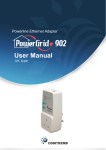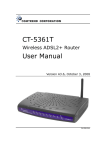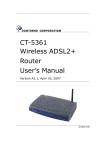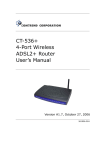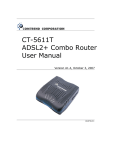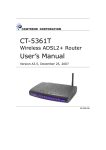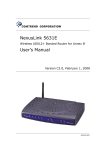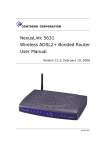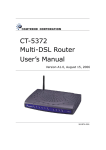Download Comtrend Corporation CT-820C User`s manual
Transcript
CT-820C VoIP Gateway User’s Manual Version A2.0, December 26, 2007 261053-034 Preface This manual provides information to network administrators. It covers the installation, operation and application of this device. The individual reading this manual is presumed to have a basic understanding of telecommunications. Technical support If you find the product to be inoperable or malfunctioning, please contact technical support for immediate service by email at [email protected] For product update, new product release, manual revision, or software upgrades, visit Comtrend Corporation at http://www.comtrend.com Warning • Before servicing, disconnect power and telephone lines from the device • Use an appropriate power supply and a UL Listed telephone line cord Power specifications are clearly stated in Appendix C: Specifications Copyright Copyright©2007 Comtrend Corporation. All rights reserved. The information contained herein is proprietary to Comtrend Corporation. No part of this document may be translated, transcribed, reproduced, in any form, or by any means without prior written permission by Comtrend Corporation. This document is subject to change without notice. 1 Table of Contents CHAPTER 1 INTRODUCTION .....................................................................................................4 1.1 FEATURES ........................................................................................................................................4 1.2 APPLICATION ...................................................................................................................................5 1.3 LED INDICATORS ............................................................................................................................6 CHAPTER 2 HARDWARE SETUP................................................................................................7 CHAPTER 3 WEB USER INTERFACE ........................................................................................8 3.1 DEFAULT SETTINGS .........................................................................................................................8 3.2 TCP/IP SETTINGS ............................................................................................................................9 3.3 LOGIN PROCEDURE........................................................................................................................10 CHAPTER 4 DEVICE INFORMATION......................................................................................13 4.1 WAN .............................................................................................................................................14 4.2 STATISTICS.....................................................................................................................................15 4.2.1 LAN Statistics..................................................................................................................15 4.2.2 WAN Statistics.................................................................................................................16 4.3 ROUTE ...........................................................................................................................................17 4.4 ARP...............................................................................................................................................18 4.5 DHCP ...........................................................................................................................................19 CHAPTER 5 ADVANCED SETUP ...............................................................................................20 5.1 WAN .............................................................................................................................................20 5.2 LAN..............................................................................................................................................28 5.3 NAT ..............................................................................................................................................29 5.3.1 Virtual Servers ................................................................................................................29 5.3.2 Port Triggering ...............................................................................................................31 5.3.3 DMZ Host .......................................................................................................................33 5.4 SECURITY ......................................................................................................................................34 5.4.1 IP Filtering .....................................................................................................................34 5.4.2 Parental Control .............................................................................................................37 5.5 QUALITY OF SERVICE ....................................................................................................................38 5.6 ROUTING .......................................................................................................................................39 5.6.1 Default Gateway .............................................................................................................39 5.6.2 Static Route.....................................................................................................................40 CHAPTER 6 WIRELESS ..............................................................................................................41 6.1 BASIC ............................................................................................................................................41 6.2 SECURITY ......................................................................................................................................43 6.3 MAC FILTER .................................................................................................................................46 6.4 WIRELESS BRIDGE .........................................................................................................................48 6.5 ADVANCED ....................................................................................................................................49 6.6 STATION INFO ................................................................................................................................52 CHAPTER 7 VOICE ......................................................................................................................53 7.1 SIP ................................................................................................................................................53 7.2 DIAL PLAN.....................................................................................................................................58 7.3 TELEPHONE CALLS ........................................................................................................................61 CHAPTER 8 DIAGNOSTICS .......................................................................................................63 CHAPTER 9 MANAGEMENT .....................................................................................................65 9.1 SETTINGS ..................................................................................................................................65 9.1.1 Backup Settings...............................................................................................................65 9.1.2 Update Settings...............................................................................................................66 9.1.3 Restore Default ...............................................................................................................67 9.2 SYSTEM LOG .................................................................................................................................68 9.3 SNMP AGENT ...............................................................................................................................71 9.4 INTERNET TIME .............................................................................................................................72 9.5 ACCESS CONTROL .........................................................................................................................73 9.5.1 Services...........................................................................................................................73 2 IP Addresses ...................................................................................................................74 9.5.2 9.5.3 Passwords .......................................................................................................................75 9.6 UPDATE SOFTWARE .......................................................................................................................76 9.7 SAVE AND REBOOT ........................................................................................................................77 APPENDIX A: FIREWALL ................................................................................................................78 APPENDIX B: PIN ASSIGNMENTS.................................................................................................81 APPENDIX C: SPECIFICATIONS....................................................................................................82 APPENDIX D: SSH CLIENT .............................................................................................................84 3 Chapter 1 Introduction The CT-820C is a powerful WLAN VoIP Gateway, providing predictable, real-time, toll-quality voice over the Internet. The CT-820C is designed for residential and business users with broadband DSL or cable access, who need to integrate Wi-Fi AP and VoIP technologies. The CT-820C offers users easy access to the Internet via WLAN or Ethernet and provides VoIP via standard analog phones. 1.1 Features • • • • • • • • • • • • • • • • • • VoIP and router integrated 802.11g/b access point VPN passthrough QoS for voice DNS SRV Dial plan Call hold Call waiting Call transfer Call forwarding 3-way conference Direct number dialing Supports emergency call Day-time parental control T.38 fax relay and passthrough Caller ID presentation and restriction Supports life line: PSTN alive when power off Remote administration: automatic firmware upgrade and configuration Optional o Centralized configuration and firmware upgrade via APS (Automatic Provision Server) 4 1.2 Application The following diagram depicts the application of the CT-820C. 5 1.3 LED Indicators The front panel LED indicators are shown in this illustration and followed by detailed explanations in the table below. LED POWER Color Mode Green Green LAN 4x~1x PHONE1 Function On The device is powered up. Off The device is powered down. On An Ethernet Link is established. Off An Ethernet Link is not established. Green Blink Green On The FXS phone 1 is off hook. Off The FXS phone 1 is on hook. On The FXS phone 2 is off hook. Off The FXS phone 2 is on hook. On The wireless module is ready and idle. Off The wireless module is disabled. Green Data transmitting or receiving over LAN. PHONE2 Green WLAN Green Blink Data transmitting or receiving over WLAN. Green On An FXO line is off hook. Off An FXO line is on hook. On An Ethernet Link is established. Off An Ethernet Link is not established. On Device attempted to become IP connected and failed (no DHCP response, no PPPoE response, PPPoE authentication failed, no IP address from IPCP, etc.) LINE Green WAN INTERNET Red 6 Chapter 2 Hardware Setup Follow the instructions below to complete the hardware setup. The diagram below shows the back panel of the device. Wi-Fi antenna Connection to Power Connect the Power jack to the power cord. Attach the power adapter to the wall outlet or other AC source. At startup, the device will perform a self-test. Wait for a few seconds until the test is finished, then the device will be ready to operate. Caution 1: If the device fails to power up, or it malfunctions, first verify that the power supply is connected correctly. Then power it on again. If the problem persists, contact our technical support engineers. Caution 2: Before servicing or disassembling this equipment always disconnect all power cords and telephone lines from their outlets. Connection to Phone1/ Phone2 Connect a telephone to either RJ11 port for VoIP service. Reset Button Restore the default parameters of the device by holding down the Reset button until the front panel LED indicators start blinking simultaneously (~ 5 seconds). If held down for more than 12 seconds, the device will go into a firmware update state (CFE boot mode). The user can then update the device from any web browser using the default IP address (http://192.168.1.1) without login. Connection to LAN/WAN ports Use a RJ45 cable to connect to a network hub or PC. You can connect the device to up to four LAN devices and one WAN device. The ports are auto-sensing MDI/X and either straight-through cable or crossover cable can be used. Connection to LINE port If you wish to connect both the router and a telephone, connect the LINE port to a POTS splitter with a RJ11 connection cable. Connection to WLAN Attach the Wi-Fi antenna to enable this feature. 7 Chapter 3 Web User Interface This section describes how to access the device via the web user interface using an Internet browser such as Microsoft Internet Explorer (version 5.0 and later). 3.1 Default Settings The following are the default settings for the device. • • • • • • • Local (LAN access) Username: root , Password: 12345 Remote (WAN access) Username: support, Password: support LAN port IP address: 192.168.1.1 Remote WAN access: disabled NAT and firewall: enabled DHCP server on LAN interface: enabled WAN IP address: none Technical Note: During power on, the device initializes all settings to default values. It will then read the configuration profile from the permanent storage section of flash memory. The default attributes are overwritten when identical attributes with different values are configured. The configuration profile in permanent storage can be created via the web user interface or telnet user interface, or other management protocols. The factory default configuration can be restored either by pushing the reset button for more than five seconds until the power indicates LED blinking or by clicking the Restore Default Configuration option in the Restore Settings screen. 8 3.2 TCP/IP Settings DHCP Mode When the device powers up, the DHCP server (on the device) will start automatically. To set your PC for DHCP mode, check the Internet Protocol properties of your Local Area Connection. You can set your PC to DHCP mode by selecting Obtain an IP address automatically in the dialog box shown below. STATIC IP Mode To configure the device manually, your PC must have a static IP address within the 192.168.1.x subnet. Follow the steps below to configure your PC IP address to use subnet 192.168.1.x. The following assumes you are running Windows XP. STEP 1: From the Network Connections window, open the Local Area Connection. (You may also access this screen by double-clicking the Local Area Connection icon on your taskbar.) Click the Properties button. 9 STEP 2: Select Internet Protocol (TCP/IP) and click the Properties button. The screen should now display as below. Change the IP address to the domain of 192.168.1.x/24 (i.e. subnet mask=255.255.255.0). STEP 3: Click OK to submit the settings. 3.3 Login Procedure Perform the following steps to login to the web user interface. NOTE: The default settings for this device can be found in 3.1 Default Settings. STEP 1: Start the Internet browser and enter the default IP address for the device in the Web address field. For example, if the IP address is 192.168.1.1, type http://192.168.1.1. NOTE: For local administration (i.e. LAN access), the PC running the browser must be attached to the Ethernet, and not necessarily to the device. For remote access (i.e. WAN), use the remote username and password. 10 11 STEP 2: A dialog box will appear, such as the one below. Enter the default username and password, as defined in section 3.1 Default Settings. Click OK to continue. NOTE: The login password can be changed later (see 9.5.3 Passwords) STEP 3: After successfully logging in, you will reach this screen. 12 Chapter 4 Device Information The web user interface is divided into two window panes, the main menu (at left) and the display screen (on the right). The main menu has the following options: Device Info, Advanced Setup, Wireless, Voice, Diagnostics, Management. Selecting one of these options will open a submenu with more options. NOTE: The menu options available within the web user interface are based upon the device configuration and user privileges (i.e. local or remote). For example, in the Advanced Setup menu, if NAT and Firewall are enabled, the main menu will display the NAT and Security submenus. If either is disabled, their corresponding menu will also be disabled. Device Info is the first selection on the main menu so it will be discussed first. Subsequent chapters will introduce the other main menu options in sequence. The Device Info submenu (outlined in red in the screenshot below) has the following selections: Summary, WAN, Statistics, Route, ARP, and DHCP. The Device Info Summary screen (shown above) is the default startup screen. It provides summary information regarding the device firmware version, TCP/IP settings, and the status of the two VOIP connections. 13 4.1 WAN Select WAN from the Device Info submenu to display the configured PVC(s). The display screen table headings (above) are described in the table below. Con. ID Shows the connection ID Category Service Interface Protocol Igmp State Status IP Address Shows the ATM service classes Shows the name for WAN connection Shows connection interfaces Shows the connection type, such as PPPoE, PPPoA, etc. Shows the status of the IGMP Proxy function Shows the connection state of the WAN connection Lists the WAN or PVC status (ex: Up/Down or Authentication Failure) Shows IP address for WAN interface 14 4.2 Statistics The Statistics screens show detailed information for LAN or WAN Interfaces. NOTE: 4.2.1 These statistics are updated every 15 seconds. LAN Statistics This screen shows statistics for Ethernet and Wireless interfaces on the LAN. Interface Received/Transmitted - Bytes - Pkts - Errs - Drops Shows connection interfaces in the following format: nas_(VPI number_VCI number). These interfaces are devised by the system and not the user. Rx/TX (receive/transmit) packet in Byte Rx/TX (receive/transmit) packets Rx/TX (receive/transmit) the packets which are errors, Rx/TX (receive/transmit) the packets which are dropped 15 4.2.2 WAN Statistics This screen shows statistics for interfaces on the WAN. Service Protocol Interface Received/Transmitted - Bytes - Pkts - Errs - Drops Shows the service type, as configured by the administrator Shows the connection type, such as PPPoE, PPPoA, etc. Shows connection interfaces in the following format: nas_(VPI number_VCI number). These interfaces are devised by the system and not the user. Rx/TX (receive/transmit) packet in Byte Rx/TX (receive/transmit) packets Rx/TX (receive/transmit) the packets which are errors, Rx/TX (receive/transmit) the packets which are dropped 16 4.3 Route Choose Route to display the routes that the route information has learned. Field Destination Gateway Subnet Mask Flag Metric Service Interface Description Destination network or destination host Next hub IP address Subnet Mask of Destination U: route is up !: reject route G: use gateway H: target is a host R: reinstate route for dynamic routing D: dynamically installed by daemon or redirect M: modified from routing daemon or redirect The 'distance' to the target (usually counted in hops). It is not used by recent kernels, but may be needed by routing daemons. Shows the name for WAN connection Shows connection interfaces 17 4.4 ARP Click ARP to display the ARP information. 18 4.5 DHCP Click DHCP to display the DHCP Leases information. 19 Chapter 5 Advanced Setup This chapter explains the setup screens for the following services: • • • WAN – Wide Area Network LAN – Local Area Network NAT – Network Address Translation • • • SECURITY QUALITY OF SERVICE ROUTING 5.1 WAN Follow the steps on the following pages to configure WAN interfaces. The screen below shows all configured WAN connections. The table below gives more details. STEP 1: Click the Edit button next to the WAN connection you wish to configure. Con. ID Category Service Interface Protocol Igmp State ID for WAN connection ATM service category, e.g. UBR, CBR, … Name of the WAN connection Name of the interface for WAN Shows IPoW or PPPoE modes Shows enable or disable IGMP proxy Shows enable or disable WAN connection 20 STEP 2: The WAN Configuration screen will display as below. Quality of Service (QoS) is enabled when the box at bottom is checked (;). Click Next. STEP 3: On this screen, you can choose either PPPoE or IPoE connection types. Once you have chosen, click Next to proceed. 22 Important Note: For PPPoE connections follow Steps 4-6 For IPoE connections follow Steps 7-9 PPPoE –PPP over Ethernet Step 4: Enter the Username and Password and select the connection options. Review the descriptions below for more details. Click Next to continue. PPP Username/PPP Password The PPP Username and the PPP password requirement are dependent on the particular requirements of the service provider. A maximum of 256 characters is allowed for the PPP user name and a maximum of 32 characters for PPP password. PPPoE service name For PPPoE service, PADI requests contain a service name-tag. Some PPPoE servers (or BRAS) of ISP check this service name-tag for connection. Dial on Demand The device can be configured to disconnect if there is no activity for a period of time by selecting this check box. When the checkbox is ticked, you must enter the inactivity timeout period. The timeout period ranges from 1 to 4320 minutes. 23 PPP IP Extension The PPP IP Extension is a special feature deployed by some service providers. Unless your service provider specially requires this setup, do not select it. The PPP IP Extension supports the following conditions: • • • • • • Allows only one PC on the LAN The public IP address assigned by the remote side using the PPP/IPCP protocol is actually not used on the WAN PPP interface. Instead, it is forwarded to the PC’s LAN interface through DHCP. Only one PC on the LAN can be connected to the remote, since the DHCP server within the device has only a single IP address to assign to a LAN device. NAT and firewall are disabled when this option is selected. The device becomes the default gateway and DNS server to the PC through DHCP using the LAN interface IP address. The device extends the IP subnet at the remote service provider to the LAN PC. That is, the PC becomes a host belonging to the same IP subnet. The device bridges the IP packets between WAN and LAN ports, unless the packet is addressed to the device’s LAN IP address. Use Static IP Address Unless your service provider specially requires this setup, do not select it. If selected, enter your static IP address in the IP Address field. Also, don’t forget to adjust your TCP/IP Settings as described in subsection 3.2 TCP/IP Settings. Enable PPP Debug Mode When this option is selected, the system will put more PPP connection information into the system log. This is for debugging errors and not for normal usage. Step 5: On this screen you may enable/disable IGMP Multicast and WAN service. Click Next to continue. 24 Enable IGMP Multicast checkbox Tick the checkbox to enable IGMP multicast (proxy). IGMP (Internet Group Membership Protocol) is a protocol used by IP hosts to report their multicast group memberships to any immediately neighboring multicast device’s. STEP 6: Click Next to display the WAN Setup-Summary screen that presents the entire configuration summary review. Click Back to modify the settings. Click Save/Reboot and skip to Step 10. 25 IPoE – Internet Protocol over Ethernet STEP 7: The WAN IP Settings screen below allows for configuration of the connection in DHCP (automatic) or Static IP (manual) modes. Enter information provided to you by your ISP to configure the WAN IP settings. DHCP mode must be enabled when Obtain an IP address automatically is chosen. Changing the default gateway or the DNS affects the whole system. Where Static mode is selected, the IP address and subnet mask must be entered, however, the Use WAN interface field does not need to be selected. STEP 8: The next screen combines NAT, IGMP and WAN service selection options. 26 Enable NAT If the LAN is configured with a private IP address, the user should select this checkbox. The user can then configure NAT-related features. If a private IP address is not used on the LAN side, this checkbox should not be selected, so as to free up system resources for improved performance. Enable Firewall If the firewall checkbox is selected, the user can configure the device firewall. Enable IGMP Multicast checkbox Tick the checkbox to enable IGMP multicast (proxy). IGMP (Internet Group Membership Protocol) is a protocol used by IP hosts to report their multicast group memberships to any immediately neighboring multicast device’s. STEP 9: Click Next to display the WAN Setup-Summary screen that presents the entire configuration summary review. Click Back to modify the settings. STEP 10: At this point, the device will save the configuration to flash memory and reboot. The Web UI will not respond until the device is ready. The Web UI should refresh to the default page automatically. If not, restart the browser and login again, following the steps in subsection 3.3 Login Procedure. 27 5.2 LAN Configure the device IP Address and Subnet Mask for LAN interface. Save button only saves the LAN configuration data. Save/Reboot button saves the LAN configuration data and reboots the device to apply the new configuration. IP Address: Enter the IP address for the LAN port. Subnet Mask: Enter the subnet mask for the LAN port. Enable UPnP: Tick the box to enable. Enable IGMP Snooping: Enable by ticking the box. Standard Mode: In standard mode, multicast traffic will flood to all bridge ports when no client subscribes to a multicast group – even if IGMP snooping is enabled. Blocking Mode: In blocking mode, the multicast data traffic will be blocked and not flood to all bridge ports when there are no client subscriptions to any multicast group. 28 To configure a secondary IP address tick the checkbox shown below. IP Address: Enter the secondary IP address for the LAN port. Subnet Mask: Enter the secondary subnet mask for the LAN port. 5.3 NAT NOTE: 5.3.1 To display the NAT function, you must enable NAT in WAN Setup. Virtual Servers Virtual Servers allow you to direct incoming traffic from the WAN side (identified by Protocol and External port) to the Internal server with private IP addresses on the LAN side. The Internal port is required only if the external port needs to be converted to a different port number used by the server on the LAN side. A maximum of 32 entries can be configured. To add a Virtual Server, click the Add button. The following screen will display. 29 Select a Service Or Custom Server Server IP Address User should select the service from the list. Or User can enter the name of their choice. Enter the IP address for the server. External Port Start Enter the starting external port number (when you select Custom Server). When a service is selected the port ranges are automatically configured. Enter the ending external port number (when you select Custom Server). When a service is selected the port ranges are automatically configured. User can select from: TCP, TCP/UDP or UDP. Enter the internal port starting number (when you select Custom Server). When a service is selected the port ranges are automatically configured Enter the internal port ending number (when you select Custom Server). When a service is selected the port ranges are automatically configured. External Port End Protocol Internal Port Start Internal Port End 30 5.3.2 Port Triggering Some applications require that specific ports in the device's firewall be opened for access by the remote parties. Port Trigger dynamically opens up the 'Open Ports' in the firewall when an application on the LAN initiates a TCP/UDP connection to a remote party using the 'Triggering Ports'. The device allows the remote party from the WAN side to establish new connections back to the application on the LAN side using the 'Open Ports'. A maximum of 32 entries can be configured. To add a Trigger Port, click the Add button. The following screen will display. 31 Select an Application Or Custom Application Trigger Port Start Trigger Port End Trigger Protocol Open Port Start Open Port End Open Protocol User should select the application from the list. Or User can enter the name of their choice. Enter the starting trigger port number (when you select custom application). When an application is selected the port ranges are automatically configured. Enter the ending trigger port number (when you select custom application). When an application is selected the port ranges are automatically configured. User can select from: TCP, TCP/UDP or UDP. Enter the starting open port number (when you select custom application). When an application is selected the port ranges are automatically configured. Enter the ending open port number (when you select custom application). When an application is selected the port ranges are automatically configured. User can select from: TCP, TCP/UDP or UDP. 32 5.3.3 DMZ Host The device will forward IP packets from the WAN that do not belong to any of the applications configured in the Virtual Servers table to the DMZ host computer. Enter the computer's IP address and click Apply to activate the DMZ host. Clear the IP address field and click Apply to deactivate the DMZ host. 33 5.4 Security NOTE: 5.4.1 The Firewall must be enabled to access this option IP Filtering IP filtering allows you to create a filter rule to identify outgoing/incoming IP traffic by specifying a new filter name and at least one condition below. All of the specified conditions in this filter rule must be satisfied for the rule to take effect. Click Save/Apply to save and activate the filter. Outgoing IP Filter NOTE: The default setting for all Outgoing traffic is ACCEPTED. To add a filtering rule, click the Add button. The following screen will display. 34 Filter Name Protocol Source IP address Source Subnet Mask Source Port (port or port:port) Destination IP address Destination Subnet Mask Destination port (port or port:port) Type a name for the filter rule. TCP, TCP/UDP, UDP or ICMP. Enter source IP address. Enter source subnet mask. Enter source port number or port range. Enter destination IP address. Enter destination subnet mask. Enter destination port number or port range. 35 Incoming NOTE: The default setting for all Incoming traffic is BLOCKED. To add a filtering rule, click the Add button. The following screen will display. To configure the parameters, please reference the Outgoing IP Filter table. 36 5.4.2 Parental Control Daytime Parental Control This feature restricts access of a selected LAN device to an outside network through the router, as per chosen days of the week and the chosen times. Click Add to display the following screen. See below for instructions. Click Save/Apply to apply the settings. 37 User Name: Name of the Filter. Browser's MAC Address: Displays MAC address of the LAN device on which the browser is running. Other MAC Address: If restrictions are to be applied to a device other than the one on which the browser is running, the MAC address of that LAN device is entered. Days of the Week: Days of the week, when the restrictions are applied. Start Blocking Time: The time when restrictions on the LAN device are put into effect. End Blocking Time: The time when restrictions on the LAN device are lifted. 5.5 Quality of Service Choose the broadband network environment: Cable or ADSL. Then set the maximum upstream bandwidth rate in Kbps. Click Save or Save/Reboot. NOTE: To display this function, QoS must be enabled in WAN Setup. 38 5.6 Routing This option allows for Default Gateway and Static Route configuration. 5.6.1 Default Gateway If Enable Automatic Assigned Default Gateway checkbox is selected, this device will accept the first received default gateway assignment from one of the enabled PVC(s). If the checkbox is not selected, enter the static default gateway and/or WAN interface. Click Save/Apply button to save it. NOTE: After enabling the Automatic Assigned Default Gateway, the device must be rebooted to activate the assigned default gateway. 39 5.6.2 Static Route The Static Route screen lists the configured static routes. Choose Add or Remove to configure the static routes. Click the Add button and the following screen will display. Enter the destination network address, subnet mask, gateway AND/OR available WAN interface then click Save/Apply to add the entry to the routing table. 40 Chapter 6 Wireless The Wireless menu allow you to enable the wireless capability, hide the access point, set the wireless network name and restrict the channel set. 6.1 Basic This screen allows you to enable or disable the wireless LAN interface, hide the network from active scans, set the wireless network name (also known as SSID) and restrict the channel set based on country requirements. 41 Option Enable Wireless Hide Access Point SSID BSSID Country Description A checkbox that enables or disables the wireless LAN interface. When selected, the Web UI displays Hide Access point, SSID, and County settings. The default is Enable Wireless. Select Hide Access Point to protect device access point from detection by wireless active scans. If you do not want the access point to be automatically detected by a wireless station, this checkbox should be de-selected. The station will not discover this access point. To connect a station to the available access points, the station must manually add this access point name in its wireless configuration. In Windows XP, go to the Network>Programs function to view all of the available access points. You can also use other software programs such as NetStumbler to view available access points. Sets the wireless network name. SSID stands for Service Set Identifier. All stations must be configured with the correct SSID to access the WLAN. If the SSID does not match, that user will not be granted access. The naming conventions are: Minimum is one character and maximum number of characters: 32 bytes. The BSSID is a 48bit identity used to identify a particular BSS (Basic Service Set) within an area. In Infrastructure BSS networks, the BSSID is the MAC (Medium Access Control) address of the AP (Access Point) and in Independent BSS or ad hoc networks, the BSSID is generated randomly. A drop-down menu that permits worldwide and specific national settings. Each county listed in the menu enforces specific regulations limiting channel range: US= worldwide, Japan=1-14, Jordan=10-13, Israel=TBD 42 6.2 Security Security options include authentication and encryption services based on the wired equivalent privacy (WEP) algorithm. WEP is a set of security services used to protect 802.11 networks from unauthorized access, such as eavesdropping; in this case, the capture of wireless network traffic. When data encryption is enabled, secret shared encryption keys are generated and used by the source station and the destination station to alter frame bits, thus avoiding disclosure to eavesdroppers. 802.11 supports two subtypes of network authentication services: open system and shared key. Under open system authentication, any wireless station can request authentication. The system that needs to authenticate with another wireless station sends an authentication management frame that contains the identity of the sending station. The receiving station then sends back a frame that indicates whether it recognizes the identity of the sending station. Under shared key authentication, each wireless station is assumed to have received a secret shared key over a secure channel that is independent from 802.11 wireless network communications channel. The following screen appears when Security is selected. The Security page allows you to configure security features of the wireless LAN interface. You can set the network authentication method, selecting data encryption, specify whether a network key is required to authenticate to this wireless network and specify the encryption strength. 43 Option Description Network It specifies the network authentication. When this checkbox is Authentication selected, it specifies that a network key be used for authentication to the wireless network. If the Network Authentication (Shared mode) checkbox is not shared (that is, if open system authentication is used), no authentication is provided. Open system authentication only performs identity verifications. Different authentication type pops up different settings requests. Choosing 802.1X, enter RADIUS Server IP address, RADIUS Port, RADIUS key and Current Network Key. Also, enable WEP Encryption and select Encryption Strength. Select the Current Network Key and enter 13 ASCII characters or 26 hexadecimal digits for 128-bit encryption keys and enter 5 ASCII characters or 10 hexadecimal digits for 64-bit encryption keys. Choosing WPA, you must enter WPA Group Rekey Interval. 44 Choosing WPA-PSK, you must enter WPA Pre-Shared Key and Group Rekey Interval. WEP Encryption Encryption strength It specifies that a network key is used to encrypt the data is sent over the network. When this checkbox is selected, it enables data encryption and prompts the Encryption Strength drop-down menu. Data Encryption (WEP Enabled) and Network Authentication use the same key. A session’s key strength is proportional to the number of binary bits comprising the session key file. This means that session keys with a greater number of bits have a greater degree of security, and are considerably more difficult to forcibly decode. This dropdown menu sets either a 64 8-bit (5-character or 10-character hexadecimal or 128 8-bit (13-character or 10-character) key. If you set a minimum 128-bit key strength, users attempting to establish a secure communications channel with your server must use a browser capable of communicating with a 128-bit session key. The Encryption Strength settings do not display unless the network Authentication (shared Mode) check box is selected. 45 6.3 MAC Filter This MAC Filter page allows access to be restricted/allowed based on a MAC address. All NICs have a unique 48-bit MAC address burned into the ROM chip on the card. When MAC address filtering is enabled, you are restricting the NICs that are allowed to connect to your access point. Therefore, an access point will grant access to any computer that is using a NIC whose MAC address is on its “allows” list. Wi-Fi device’s and access points that support MAC filtering let you specify a list of MAC addresses that may connect to the access point, and thus dictate what devices are authorized to access the wireless network. When a device is using MAC filtering, any address not explicitly defined will be denied access. MAC Restrict mode: Off - disables MAC filtering; Allow – permits access for the specified MAC address; deny; reject access of the specified MAC address, then click the SET button. To delete an entry, select the entry at the bottom of the screen and then click the Remove button, located on the right hand side of the screen. To add a MAC entry, click Add and enter MAC address The following screen will appear. Enter the MAC address and click Save/Apply to add the MAC address to the wireless MAC address filters. 46 Option MAC Restrict Mode MAC Address Description Radio buttons that allow settings of; Off: MAC filtering function is disabled. Allow: Permits PCs with listed MAC addresses to connect to the access point. Deny: Prevents PCs with listed MAC from connecting to the access point. Lists the MAC addresses subject to the Off, Allow, or Deny instruction. The Add button prompts an entry field that requires you type in a MAC address in a two-character, 6byte convention: xx:xx:xx:xx:xx:xx where xx are hexadecimal numbers. The maximum number of MAC addresses that can be added is 60. 47 6.4 Wireless Bridge This page allows you to configure wireless bridge features of the wireless LAN interface. You can select Wireless Bridge (also known as Wireless Distribution System) to disable access point functionality. Selecting Access Point enables access point functionality. Wireless bridge functionality will still be available and wireless stations will be able to associate to the AP. Select Disabled in Bridge Restrict to disable wireless bridge restriction. Any wireless bridge will then be granted access. Selecting Enabled or Enabled (Scan) enables wireless bridge restriction. Only those bridges selected in Remote Bridges will be granted access. Mode AP Mode Bridge Restrict Options Access Point Wireless Bridge Enabled Enabled (Scan) Disabled 48 6.5 Advanced The Advanced page allows you to configure advanced features of the wireless LAN interface. You can select a particular channel on which to operate, force the transmission rate to a particular speed, set the fragmentation threshold, set the RTS threshold, set the wakeup interval for clients in power-save mode, set the beacon interval for the access point and set whether short or long preambles are used. Click Apply to configure the advanced wireless options. Option AP Isolation Band Channel Auto Channel Timer (min) Description Select On or Off. By enabling this feature, wireless clients associated with the Access Point will be able to connect to each other. The new amendment allows IEEE 802.11g units to fall back to speeds of 11 Mbps, so IEEE 802.11b and IEEE 802.11g devices can coexist in the same network. The two standards apply to the 2.4 GHz frequency band. IEEE 802.11g creates data-rate parity at 2.4 GHz with the IEEE 802.11a standard, which has a 54 Mbps rate at 5 GHz. (IEEE 802.11a has other differences compared to IEEE 802.11b or g, such as offering more channels.) Drop-down menu that allows selection of specific channel Auto channel scan timer in minutes (0 to disable) 49 54g™ Rate Drop-down menu that specifies the following fixed rates: Auto: Default. Uses the 11 Mbps data rate when possible but drops to lower rates when necessary. 1 Mbps, 2Mbps, 5Mbps, or 11Mbps fixed rates. The appropriate setting is dependent on signal strength. Multicast Rate Setting multicast packet transmit rate Basic Rate Setting basic transmit rate Fragmentation Threshold A threshold, specified in bytes, that determines whether packets will be fragmented and at what size. On an 802.11 WLAN, packets that exceed the fragmentation threshold are fragmented, i.e., split into, smaller units suitable for the circuit size. Packets smaller than the specified fragmentation threshold value are not fragmented. Enter a value between 256 and 2346. If you experience a high packet error rate, try to slightly increase your Fragmentation Threshold. The value should remain at its default setting of 2346. Setting the Fragmentation Threshold too low may result in poor performance. RTS Threshold Request to Send, when set in bytes, specifies the packet size beyond which the WLAN Card invokes its RTS/CTS mechanism. Packets that exceed the specified RTS threshold trigger the RTS/CTS mechanism. The NIC transmits smaller packet without using RTS/CTS. The default setting of 2347 (maximum length) disables RTS Threshold. DTIM Interval Delivery Traffic Indication Message (DTIM), also known as Beacon Rate. The entry range is a value between 1 and 65535. A DTIM is a countdown informing clients of the next window for listening to broadcast and multicast messages. When the AP has buffered broadcast or multicast messages for associated clients, it sends the next DTIM with a DTIM Interval value. AP Clients hear the beacons and awaken to receive the broadcast and multicast messages. The default is 1. Beacon Interval The amount of time between beacon transmissions. Each beacon transmission identifies the presence of an access point. By default, radio NICs passively scan all RF channels and listen for beacons coming from access points to find a suitable access point. Before a station enters power save mode, the station needs the beacon interval to know when to wake up to receive the beacon (and learn whether there are buffered frames at the access point). The entered value is represented in ms. Default is 100. Acceptable entry range is 1 to 0xffff (65535) 50 Maximum Associated Clients Xpress TM Technology 54g TM Mode 54g Protection Preamble Type Transmit Power The maximum number of clients that may connect to the access point. The device supports up to 128. Xpress Technology is compliant with draft specifications of two planned wireless industry standards. Select the mode to 54g Auto for the widest compatibility. Select the mode to 54g Performance for the fastest performance among 54g certified equipment. Set the mode to 54g LRS if you are experiencing difficulty with legacy 802.11b equipment. In Auto mode the device will use RTS/CTS to improve 802.11g performance in mixed 802.11g/802.11b networks. Turn protection off to maximize 802.11g throughput under most conditions. Short preamble is intended for application where maximum throughput is desired but it doesn’t cooperate with the legacy. Long preamble interoperates with the current 1 and 2 Mbit/s DSSS specification as described in IEEE Std 802.11-1999 The router will set different power output (by percentage) according to this selection. 51 6.6 Station Info This page shows authenticated wireless stations and their status. BSSID Associated Authorized The BSSID is a 48bit identity used to identify a particular BSS (Basic Service Set) within an area. In Infrastructure BSS networks, the BSSID is the MAC (Medium Access Control) address of the AP (Access Point) and in Independent BSS or ad hoc networks, the BSSID is generated randomly. Lists all the stations that are associated with the Access Point, along with the amount of time since packets were transferred to and from each station. If a station is idle for too long, it is removed from this list. Lists those devices with authorized access. 52 Chapter 7 Voice This chapter first describes the SIP and Dial Plan configuration screens. The last section (7.3 Telephone Calls) describes how to use the VoIP (Voice over IP) and PSTN (Public Switched Telephone Network) voice services. 7.1 SIP Session Initiation Protocol (SIP) is a signaling protocol for Internet conferencing, telephony, presence, events notification and instant messaging. It is the Internet Engineering Task Force's (IETF's) standard for multimedia conferencing over IP. It is designed to address the functions of signaling and session management within a packet telephony network. Signaling allows call information to be carried across network boundaries. Session management provides the ability to control the attributes of an end-to-end call. Session Initiation Protocol is a peer-to-peer protocol. There are four components in the SIP standard: (a) User Agents (UA) - SIP phone clients (hardware or software) (b) Proxy Server – relays data between UA and external servers (c) Registrar Server - a server that accepts register requests from UA (d) Redirect Server – provides an address lookup service to UA 53 To access the SIP configuration screen, click SIP from the Voice submenu. Once the settings are configured click Apply and Save All VoIP Parameters to reset the VoIP service to use the new settings. 54 This table describes the SIP configuration options shown on the previous page. Interface name Local Selection Preferred codec Preferred ptime Use SIP proxy Register Expire Time SIP domain name Use SIP outbound proxy Enable SIP tag matching (Uncheck for Vonage Interop). Remote server for SIP log messages DispName VoIP Phone Number Auth. ID Auth. Password PSTN route rule Emergency calls Number 1 & 2 Max Digits RFC2833 Outband DTMF RTP Payload Type for RFC2833 WAN interface name Set tone, ring type and physical characteristics for each specific country. The default is G.711U. The default is 20. A proxy is an intermediary program that acts as both a server and a client for the purpose of making requests on behalf of other clients. Requests are serviced internally or transferred to other servers. A proxy interprets and, if necessary, rewrites a request message before forwarding it. Input IP address or domain name of the SIP proxy server, used for VOIP service. 5060 is the default (change based on your VoIP service provider). The time period that the user would like the registration to be valid with the Registrar/ Proxy Server. The default is 300 seconds. Provided by your VoIP service provider. Select if required by your VoIP provider. Select if required by your VoIP provider. Enable or disable remote server SIP log messages. The caller ID display name. As the modem has two FXS, two phone numbers can be listed. The authentication username for the Registrar/Proxy, as assigned by the VOIP service provider. The authentication password for the Registrar/proxy, as assigned by the VOIP service provider. If PSTN route rule is Auto, an incoming PSTN call will ring an idle phone, either Phone1 or Phone2 (if Phone1 is busy). If PSTN route rule is Fixed, an incoming PSTN call will attempt to ring only the assigned phone line (Phone1 or Phone2). Emergency phone numbers. Landline or VoIP can be selected. Please Note: These numbers must be changed to correspond to the emergency numbers that are used in your location. Sets the maximum number of digits for the phone number. Enable the special use of RTP packets to transmit digit events. Payload types are defined in RFC 2833, RTP 55 Enable Pass '*' Call Feature to Sip Proxy Enable Internal Call Enable Phone 1/2 Hotline FAX mode Differentiating PSTN & VoIP Ring Tone Differentiating PSTN & VoIP Dial Tone Enable Trusted IP for SIP servers Enable Phone 1/2 Call Waiting Phone 1/2 Call Forward Feature Payload for DTMF Digits, Telephony Tones and Telephony Signals. A payload type is a number from 96 to 127 that identifies the type of payload carried in the packet. The payload type should be identical on the GW and call agent. Only Tick if your VoIP Service Provider requires this. Tick if you would like to intercom your 2nd VoIP phone. This setting is used if you require a certain phone number to always be dialled when you pickup your VoIP phone on Line 1 or Line 2. Setting this would mean that you can not make calls to any other number except the one programmed in here. Choose Force T.38 or Pass through (G711u). You can plug a fax machine into either phone port and send or receive faxes. Note: This depends upon fax compatibility with your VoIP service provider. When there is an incoming call, you can set the ring tone you hear to let you know this call is coming from PSTN or VoIP. When you take your VoIP phone off hook, you can set the tone sound you hear to let you know you have selected a VoIP line. It is advised to have different sounding tone with the normal PSTN tone as you then know your VoIP account is active and connected and you will not make expensive calls on your normal PSTN account if your VoIP account is inactive for whatever reason. Default is disabled. Allows you to hear another incoming call whilst you are on the phone, if call waiting is enabled on a line, and you hear the call waiting tone during a call, press flash to answer the second call. The first call is automatically placed on hold. To switch between calls, press flash again. Allows for the creation of a simple line rotary phone system equivalent. If you have 2 x VoIP lines and you only want to publish 1 phone number then you should set the main VOIP number to Phone 1 and create a Call Forward Type rule to When Busy or No Answer and type in the 2nd VoIP number into the Call Forward Phone Number field (include the STD code). You would normally disable Call Waiting at least on Phone 1 so that all your incoming calls to Phone 1 Forward to Phone 2, when 56 Signaling QoS Enable Differentiated Service Configuration Assign Differentiated Services Code Point (DSCP) Mark Media Qos Enable Differentiated Service Configuration Assign Differentiated Services Code Point (DSCP) Mark you are on Phone 1. Please note that you may not be able to Call Forward from Line 1 to Line 2 and then if Line 2 is also busy to Call Forward to a 3rd party number even if you have correctly setup a rule for Call Forward on Line 2. Success of this operation depends on your VoIP Service Provider’s network ability. The function set creates a traffic class rule to classify the VoIP SIP upstream traffic, assign queuing priority and optionally overwrite the IP header TOS byte. When enabled Assign Differentiated Service Code Point (DSCP) Mark will be displayed. When disabled, mark the priority and type of IP service for all SIP upstream traffic. The selected Code Point gives the corresponding priority to the packets that satisfies the rules set below. The function set creates a traffic class rule to classify the VoIP RTP upstream traffic, assign queuing priority and optionally overwrite the IP header TOS byte. When enabled Assign Differentiated Service Code Point (DSCP) Mark will be displayed. When disabled, mark the priority and type of IP service for all RTP upstream traffic. The selected Code Point gives the corresponding priority to the packets that satisfies the rules set below. 57 7.2 Dial Plan With this function you can modify the translation rules for phone numbers. This is can be done by establishing Incoming and Outgoing rules, while the Advance screen provides for even greater customization. All three screens are similar in design as can be seen in the figures below. Outgoing Incoming Advance Each screen has the same four buttons at top: Add Click this button to go to the add rule screen. Follow the detailed instructions given there. After completing the form click Apply to add a new dial plan rule. Remove Select the dial plan rule you wish to delete and click the Remove button. 58 Modify Select a dial plan rule and click this button to go to the modify rule screen. Follow the detailed instructions given there. After adjusting the values in the form, click Apply to change the dial plan rule. Apply/Save Use this button to save and apply a new Dial Plan configuration. CONFIGURATION PARAMETERS The following table of parameters is included for your reference. For more detailed instructions consult the Add/Modify rules configuration screens. Index Priority Prefix Destination Mini digit Max digit Delete digit Insert digit Action Use this radio button to select a rule for modification or removal All the rules will be applied in order according to their priority. This field can be set to any number between 0 and 32767 with lower values indicating higher priority Prefix digit sequence syntax VoIP or PSTN The minimum number of prefix digits The maximum number of digits The number of prefix digits to delete The prefix digits to insert Allow or Deny the action EXAMPLE We will use the Advanced configuration option for our example. To begin, select Advanced from the Dial Plan menu. The user interface should display as below. Click the Add button to go to the Advance rule add screen, shown below. 59 For this example, assume that the device needs to convert the following 11 digit dial sequence “123-xxx-xxxxx” into “002-xxx-xxxxx”, where “x” is any number. Here are the steps involved. Step 1: Enter any number between 0 and 32767 in the Priority field. Step 2: In the prefix field enter “123”. Step 3: Enter “3” in the Mindigit field to limit the prefix minimum to 3 digits. Step 4: Enter “11” or greater as the MaxDigit value to accept all 11 digits of the dial sequence. Step 5: In the DeleteDigit field, enter “3” to delete the “123” prefix Step 6: Enter “002” in the InsertDigit field to add “002” as the prefix. Step 7: Click the Apply button to return to the Advance configuration screen. Step 8: Click Apply/Save to apply this rule to all outgoing calls. NOTE: This prefix swap example is especially helpful for corporate environments where the device is dialing through a PBX system. The Dial Plan function is designed for maximum flexibility for your particular environment. If you have a question contact your ISP for detailed instructions. 60 7.3 Telephone Calls To make a call, simply dial the number. The dial plan (i.e. the dialed digits) is normally customized for each installation. The default dial plan delivered by Comtrend allows dialing of 4-digit extensions or direct IP addresses. Shorter extension numbers (e.g. 3-digits) can be dialed by completing the dial string with a final #. When a Call Server (SIP Proxy Server) is configured into the system, the dialed digits are translated and routed by the Call Server to the correct destination as registered with the Call Server. If no Call Server is configured, calls can still be made using 4-digit extensions, rather than using full IP addresses. The originator translates the dialed-digits to a destination device as follows: First Digit: Line identifier (for multi-line gateways) Remaining digits: Host number part of an IP address. The Network number part is considered to be the same as the caller’s IP address. For example, if a caller at address 10.136.64.33/24 dials “2023”, the call will be placed to the second line at address 10.136.64.23. All devices have to be on the same Class C subnet (24 bit subnet mask). To dial an IP address directly, dial the IP address digits, using keypad * as the dot. Complete the address with a final * or #. When using IP address dialing it is not possible to specify which line at a gateway is called, so the gateway always routes IP-address dialed calls to the first line. Network busy tone (fast busy) will be played for unknown or unreachable destinations. To answer a call, pick up the phone or press the handsfree button. Caller ID The Call Manager delivers Calling Number when placing calls. The calling number is transmitted to the analog line for CLASS recognition. Call Hold To put a call on hold, press flash then hang up (optional). To return to the original call, press flash or pick up the phone. The phone will issue a short ring burst every 30 seconds or so while on-hook to remind you that a call is on hold. Call Transfer • To transfer a call, press flash then dial the new number. • To transfer immediately, hang up (blind transfer). • To transfer with consultation, wait for the party to answer, consult, and hang up. • To abort the transfer (if the third party does not answer), press flash to return to the original call. 61 Conference Calling To turn a two-party call into a three-party conference call, press flash and dial the third party. Wait for the party to answer, then press flash. To drop the third party and return to a two-party call, press flash again. To drop yourself out of the conference, hang up. The call will be transferred (so that the other two parties remain connected to each other). In conference mode, the conference initiator performs the audio bridge/mixing function – there are only two voice streams established. Call Waiting If call waiting is enabled on a line, and you hear the call waiting tone during a call, press flash to answer the second call. The first call is automatically placed on hold. To switch between calls, press flash again. • • To disable the call waiting feature, dial *60. To enable the call waiting feature, dial *61. Call forward feature settings (Busy or All) takes priority over the call waiting feature. The call waiting feature is ignored on new incoming calls if there is already a call on hold or in conference. Call Forward Number • To set the call forward number, dial *74 then the number. Note that this does not actually enable forwarding; to do so, select the call forward action as described below. • To disable all call forwarding features, dial *70 Call Forward No Answer • To enable call forward on no answer, dial *71. Incoming calls will be forward if unanswered for 18 seconds. Call Forward Busy • To enable call forward if busy, dial *72. Incoming calls will be immediately forwarded if the phone is off-hook. Call Forward All • To enable call forward for all calls, dial *73. • To disable the “forward all calls” feature, dial *75. Previous settings for Call Forward Busy or No Answer are not modified. Call Return To place a call to the last known incoming caller (unanswered or not), dial *69. Redial • To redial the last outgoing number, dial *68. 62 Chapter 8 Diagnostics The Diagnostics menu provides feedback on the connection status of the device. The individual tests are listed below. If a test displays a fail status, click Rerun Diagnostic Tests at the bottom of this page to make sure the fail status is consistent. If the test continues to fail, click Help and follow the troubleshooting procedures. Test LAN Connection Description Pass: Indicates that the Ethernet interface from your computer is connected to the LAN port of this device. Fail: Indicates that the device does not detect the Ethernet interface from your computer. WAN connection Pass: : Indicates that the WAN interface from the modem (ADSL/cable) is connected to the WAN port of this device. Fail: Indicates that the device does not detect the WAN interface from the modem (ADSL/cable). Wireless connection Pass: Indicates that the Wireless interface from your computer is connected to the wireless network. Down: Indicates that the device does not detect the wireless network. Ping Default Gateway Pass: Indicates that the device can communicate with the first entry point to the network. It is usually the IP address of the ISP local router. Fail: Indicates that the device was unable to communicate with the first entry point on the network. It may not have an effect on your Internet connectivity. Therefore if this test fails but you are still able to access the Internet, there is no need to troubleshoot this issue. 63 Test Ping Primary Domain Name Server Description Pass: Indicates that the device can communicate with the primary Domain Name Server (DNS). Fail: Indicates that the device was unable to communicate with the primary Domain Name Server (DNS). It may not have an effect on your Internet connectivity. Therefore if this test fails but you are still able to access the Internet, there is no need to troubleshoot this issue. 64 Chapter 9 Management The Management section of the device supports the following maintenance functions and processes: • • • • • • • Settings System log SNMP Agent Internet Time Access Control Update software Save/Reboot 9.1 Settings The Settings screen allows for the backup, retrieval and restoration of settings. Each of these functions is accessed from the Settings submenu and described in more detail in the following discussion. 9.1.1 Backup Settings Select Backup from the Settings submenu to access the screen shown below. Click the Backup Settings button to save the current configuration settings. You will be prompted to define the location of a backup file to save to your PC. 65 9.1.2 Update Settings Select Update from the Settings submenu to access the screen shown below. Enter a previously saved configuration backup file in the Settings File Name field and click the Update Settings button to load it. If you forget the filename and path you can search your PC by clicking on the Browse button. 66 9.1.3 Restore Default Select Restore Default from the Settings submenu to access the screen shown below. Click the Restore Default Settings button to restore the device to the default firmware settings. Restoring system settings require a device reboot. The default settings can be found in section 3.1 Default Settings. After the Restore Default Configuration button is selected, the following screen appears. Close the device Configuration window and wait for 2 minutes before reopening your web browser. If necessary, reconfigure your PC's IP address to match your new configuration. After a successful reboot, the browser will return to the Device Info screen. If the browser does not refresh to the default page, close and restart the browser. NOTE: The Restore Default function has the same effect as the reset button. The device board hardware and the boot loader support the reset to default button. If the reset button is continuously pushed for more than 5 seconds (and not more than 12 seconds), the boot loader will erase the configuration settings saved on flash memory. 67 9.2 System Log The System Log option under Management allows for the viewing of system events and configuration of related options. The default setting for the System Log is enabled. Follow the steps below to enable and view the System Log. STEP 1: Click Configure System Log to continue. Step 2: Select from the desired system log options (see table below) and then click Save/Apply. 68 Option Description Log Indicates whether the system is currently recording events. The user can enable or disable event logging. By default, it is disabled. To enable it, click Enable and then Apply button. Log Allows you to configure the event level and filter out unwanted events level below this level. The events ranging from the highest critical level “Emergency” down to this configured level will be recorded to the log buffer on the CT-820C SDRAM. When the log buffer is full, the newer event will wrap up to the top of the log buffer and overwrite the old event. By default, the log level is “Debugging,” which is the lowest critical level. The following log levels are • • • • • • • • Emergency = system is unstable Alert = action must be taken immediately Critical = critical conditions Error = Error conditions Warning = normal but significant condition Notice Informational Debugging = debug-level messages Emergency is the most serious event level, whereas Debugging is the least important. For instance, if the log level is set to Debugging, all the events from the lowest Debugging level to the most critical level Emergency level will be recorded. If the log level is set to Error, only Error and the level above will be logged. Display Allows the user to select the logged events and displays on the View Level System Log page for events of this level and above to the highest Emergency level. 69 Option Description Mode Allows you to specify whether events should be stored in the local memory, or be sent to a remote syslog server, or both simultaneously. If remote mode is selected, view system log will not be able to display events saved in the remote syslog server. When either Remote mode or Both mode is configured, the WEB UI will prompt the user to enter the Server IP address and Server UDP port. 3. Click View System Log. The results are displayed in as follows. 70 9.3 SNMP Agent Simple Network Management Protocol (SNMP) allows a management application to retrieve statistics and status from the SNMP agent in this device. Select the desired values and click Save/Apply to configure the SNMP options. 71 9.4 Internet Time NOTE: Internet Time must be activated to use Parental Control (section 5.4.2) The Internet Time option under the Management submenu configures the time settings of the device. To automatically synchronize with Internet timeservers, tick the corresponding box displayed on this screen, then click Save/Apply. On the screen below, choose your Time Zone and click Save/Apply to continue. Field Descriptions First NTP time server: Select your required server. Second NTP time server: Select second time server if required. Time zone offset: Select your local time zone. 72 9.5 Access Control The Access Control option under Management menu bar configures access related parameters in three areas: Services, IP Addresses, and Passwords. Use Access Control to control local and remote management settings for the device. 9.5.1 Services The Services option limits or opens the access services over the LAN or WAN. These access services are available: FTP, HTTP, ICMP, SSH, TELNET, and TFTP. Enable a service by ticking its checkbox. Click Save/Apply to continue. 73 9.5.2 IP Addresses The IP Addresses option limits local access by IP address. When the Access Control Mode is enabled, only the IP addresses listed here can access the device. Before enabling Access Control Mode, add IP addresses with the Add button. On this screen, enter the IP address of a local PC which you wish to give management permissions. Click Save/Apply to continue. 74 9.5.3 Passwords The Passwords option configures the user account access passwords for the device. Access to the device is limited to the following three user accounts: • • • NOTE: root is to be used for local unrestricted access control. support is to be used for remote maintenance of the device user is to be used to view information and update device firmware. Default account passwords can be found in section 3.1 Default Settings Use the fields in the screen below to select a username and change its password. Passwords must be 16 characters or less. Click Save/Apply to continue. 75 9.6 Update Software The Update Software screen allows for firmware updates. Manual device upgrades from a locally stored file can be performed using the following screen. Step 1: Obtain an updated software image file from your ISP. Step 2: Enter the path and filename of the firmware image file in the Software File Name field or click the Browse button to locate the image file. Step 3: Click the Update Software button once to upload and install the file. NOTE 1: The update process will take about 2 minutes to complete. The device will reboot and the browser window will refresh to the default screen upon successful installation. It is recommended that you compare the Software Version at the top of the Device Info Summary screen (see screenshot below) with the firmware version installed, to confirm the installation was successful. 76 9.7 Save and Reboot The Save/Reboot option saves the current configuration and reboots the device. Close your browser, wait about 2 minutes and then restart the web user interface. NOTE: It may be necessary to reconfigure your TCP/IP settings to adjust for the new configuration. For example, if you disable the DHCP server you will need to apply Static IP settings. In this case, see section 3.2 TCP/IP Settings for detailed instructions. NOTE: If you lose all access to the web user interface, simply press the reset button on the rear panel for 5-7 seconds to restore to default settings. 77 Appendix A: Firewall Stateful Packet Inspection Refers to an architecture, where the firewall keeps track of packets on each connection traversing all its interfaces and makes sure they are valid. This is in contrast to static packet filtering which only examines a packet based on the information in the packet header. Denial of Service attack Is an incident in which a user or organization is deprived of the services of a resource they would normally expect to have. Various DoS attacks the device can withstand are: ARP Attack, Ping Attack, Ping of Death, Land, SYN Attack, Smurf Attack and Tear Drop. TCP/IP/Port/Interface Filter These rules help in the filtering of traffic at the Network layer i.e. Layer 3. When a Routing interface is created "Enable Firewall" must be checked. Navigate to Advanced Setup -> Security -> IP Filtering. Outgoing IP Filter Helps in setting rules to DROP packets from the LAN interface. By default if Firewall is Enabled all IP traffic from LAN is allowed. By setting up one or more filters, particular packet types coming from the LAN can be dropped. Filter Name: User defined Filter Name. Protocol: Can take on any values from: TCP/UDP, TCP, UDP or ICMP Source IP Address/Source Subnet Mask: Packets with the particular "Source IP Address/Source Subnet Mask" combination will be dropped. Source Port: This can take on either a single port number or a range of port numbers. Packets having a source port equal to this value or falling within the range of port numbers(portX : portY) will be dropped. Destination IP Address/Destination Subnet Mask: Packets with the particular "Destination IP Address/Destination Subnet Mask" combination will be dropped. Destination Port: This can take on either a single port number or a range of port numbers. Packets having a destination port equal to this value or falling within the range of port numbers(portX : portY) will be dropped. Examples: 1. Filter Name Protocol Source Address Source Subnet Mask Source Port Destination Address Destination Subnet Mask Destination Port : : : : : : : : 78 Out_Filter1 TCP 192.168.1.45 255.255.255.0 80 NA NA NA This filter will Drop all TCP packets coming from LAN with IP Address/Sub. Mask 192.168.1.45/24 having a source port of 80 irrespective of the destination. All other packets will be Accepted. 2. Filter Name Protocol Source Address Source Subnet Mask Source Port Destination Address Destination Subnet Mask Destination Port : : : : : : : : Out_Filter2 UDP 192.168.1.45 255.255.255.0 5060:6060 172.16.13.4 255.255.255.0 6060:7070 This filter will drop all UDP packets coming from LAN with IP Address/ Subnet Mask 192.168.1.45/24 and a source port in the range of 5060 to 6060, destined to 172.16.13.4/24 and a destination port in the range of 6060 to 7070. Incoming IP Filtering: Helps in setting rules to ACCEPT packets from the WAN interface. By default all incoming IP traffic from WAN is Blocked, if the Firewall is Enabled. By setting up one or more filters, particular packet types coming from the WAN can be Accepted. Filter Name: User defined Filter Name. Protocol: Can take on any values from TCP/UDP, TCP, UDP or ICMP Source IP Address/Source Subnet Mask: Packets with the particular "Source IP Address/Source Subnet Mask" combination will be accepted. Source Port: This can take on either a single port number or a range of port numbers. Packets having a source port equal to this value or falling within the range of port numbers(portX : portY) will be accepted. Destination IP Address/Destination Subnet Mask: Packets with the particular "Destination IP Address/Destination Subnet Mask" combination will be accepted. Destination Port: This can take on either a single port number or a range of port numbers. Packets having a destination port equal to this value or falling within the range of port numbers(portX : portY) will be accepted. The WAN interface on which these rules apply needs to be selected by user. Examples: 1. Filter Name Protocol Source Address Source Subnet Mask Source Port Destination Address Destination Sub. Mask Destination Port : : : : : : : : 79 In_Filter1 TCP 210.168.219.45 255.255.0.0 80 NA NA NA Selected WAN interface: mer_0_35/nas_0_35 This filter will ACCEPT all TCP packets coming from WAN interface mer_0_35/nas_0_35 with IP Address/Sub. Mask 210.168.219.45/16 having a source port of 80 irrespective of the destination. All other incoming packets on this interface are DROPPED. 2. Filter Name Protocol Source Address Source Subnet Mask Source Port Destination Address Destination Subnet Mask Destination Port : : : : : : : : In_Filter2 UDP 210.168.219.45 255.255.0.0 5060:6060 192.168.1.45 255.255.255.0 6060:7070 This rule will ACCEPT all UDP packets coming from WAN interface mer_0_35/nas_0_35 with IP Address/Subnet Mask 210.168.219.45/16 and a source port in the range of 5060 to 6060, destined to 192.168.1.45/24 and a destination port in the range of 6060 to 7070. All other incoming packets on this interface are DROPPED. Parental Control This feature restricts access of a selected LAN device to an outside Network through the router, as per chosen days of the week and the chosen times. User Name: Name of the Filter. Browser's MAC Address: Displays MAC address of the LAN device on which the browser is running. Other MAC Address: If restrictions are to be applied to a device other than the one on which the browser is running, the MAC address of that LAN device is entered. Days of the Week: Days of the week, when the restrictions are applied. Start Blocking Time: The time when restrictions on the LAN device are put into effect. End Blocking Time: The time when restrictions on the LAN device are lifted. Example: User Name: FilterJohn Browser's MAC Address: 00:25:46:78:63:21 Days of the Week: Mon, Wed, Fri Start Blocking Time: 14:00 End Blocking Time: 18:00 When this rule i.e. FilterJohn is entered, a LAN device with MAC Address of 00:25:46:78:63:21 will be restricted access to the outside network on Mondays, Wednesdays and Fridays, from 2pm to 6pm. On all other days and time this device will have access to the outside Network. 80 Appendix B: Pin Assignments Pin Assignments of the RJ11 Port Line port (RJ11) Pin 1 2 3 Definition ADSL_RING Pin 4 5 6 Definition ADSL_TIP - Pin 5 6 7 8 Definition NC Receive dataNC NC Pin assignments of the LAN Port LAN Port (RJ45) Pin 1 2 3 4 Definition Transmit data+ Transmit dataReceive data+ NC 81 Appendix C: Specifications WAN Interface Ethernet x 1 LAN Interface Ethernet x 4 WLAN Standard IEEE802.11g, backward compatible with 802.11b Encryption 64, 128-bit Wired Equivalent Privacy (WEP) Channels 11 (US, Canada)/ 13 (Europe)/ 14 (Japan) Data Rate Up to 54Mbps MAC Address Filtering, WEP, WPA, IEEE 802.1x 10, 25, 50, 100mW @ 22MHz channel bandwidth Output power level can be selected according to the environment Analog Interface FXS x 2, FXO x 1 (Life Line) WAN Connection PPPoE (RFC 2516), DHCP Client, Static IP Management SNMP, SNTP, Telnet, Web-based management, Configuration backup and restoration. Software upgrade via HTTP, TFTP client and server or FTP server. Centralized configuration and firmware upgrade via APS (optional) Bridge Functions Transparent bridging and learning............ IEEE 802.1d IGMP Proxy .......................................... Yes IGMP Snooping ..................................... Yes Routing Functions Static route, RIP v1/v2, NAT/PAT, DMZ, DHCP Client/Server/Relay, DNS Proxy, DDNS, IGMP proxy, ARP 82 Security Functions Authentication protocols......................... PAP, CHAP VPN..................................................... PPTP/L2TP/IpSec pass-through Stateful Packet Inspection, Packet filtering, Denial Of Service protection, Traffic Conditioning, WFQ-based Bandwidth Management, HTTP proxy QoS L3 policy-based QoS, IP QoS, ToS Voice Functions SIP ..................................................... RFC 3261 Codec.................................................. G.711a/u, G.729, ILBC RTP ..................................................... RFC 1889 SDP .................................................... RFC 2327 Caller ID .............................................. ETSI based Life line/Emergency call ......................... Yes Echo cancellation .................................. G.168 Silence suppression ............................... Yes T.38/Fax passthrough ............................ Yes DTMF .................................................. RFC2833/in-band QoS .................................................... Yes ToS/DSCP bit tagging............................. Yes Dial Plan .............................................. Yes Power External power adapter Input: AC100-240V Output: DC12V/1.5A Environmental Conditions Operating temperature........................... 0 ~ 50 degrees Celsius Relative humidity .................................. 5 ~ 90% (non-condensing) Dimensions 205 mm (W) x 47 mm (H) x 145 mm (D) NOTE: Specifications are subject to change without notice 83 Appendix D: SSH Client Linux OS comes with an ssh client. Microsoft Windows does not have ssh client but there is a public domain one called “putty” that you can download here: http://www.chiark.greenend.org.uk/~sgtatham/putty/download.html To access the device using Linux ssh client: From LAN: Use the device WEB UI to enable SSH access from LAN. (default is enabled) type: ssh -l root 192.168.1.1 From WAN: In the device, use WEB UI to enable SSH access from WAN. type: ssh -l support device-WAN-ip-address To access the device using the Windows “putty” ssh client: From LAN: Use the device WEB UI to enable SSH access from LAN (default is enabled) type: putty -ssh -l admin 192.168.1.1 From WAN: In the device, use WEB UI to enable SSH access from WAN. type: putty -ssh -l support device-WAN-ip-address 84




















































































